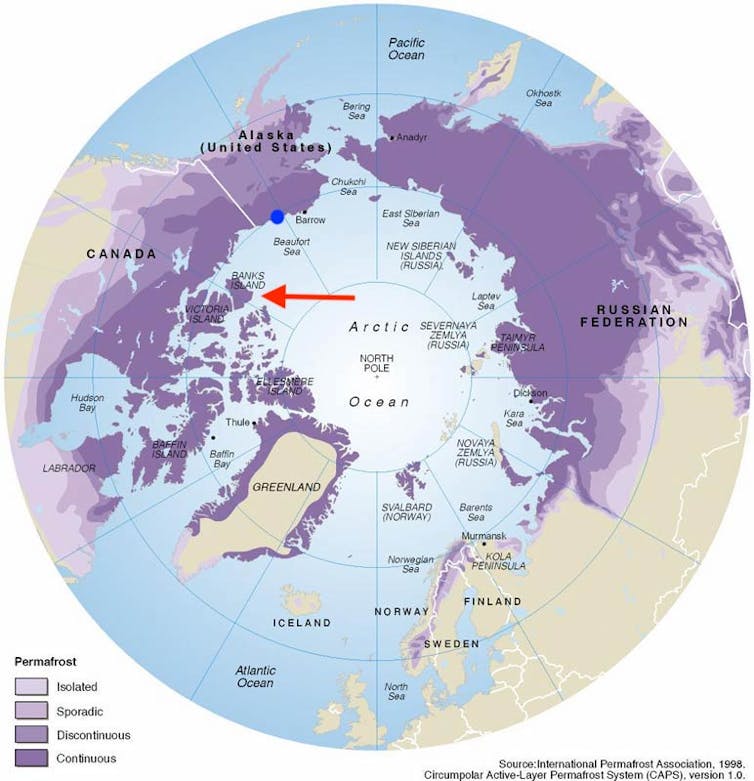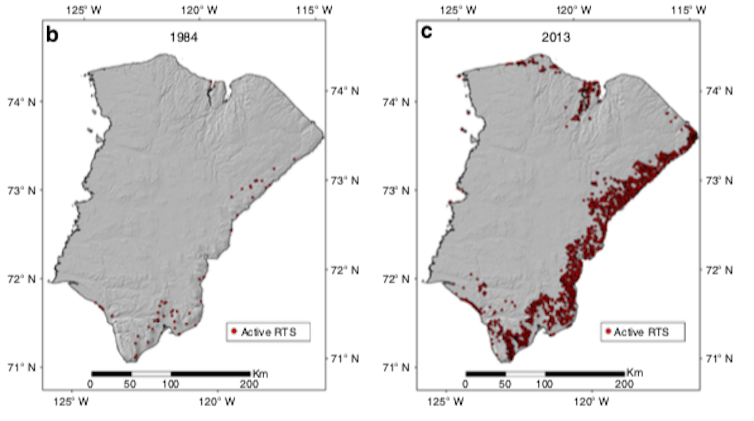By Dave Petley, University of Sheffield
Early spring temperatures in the town of Deadhorse, on the north coast of Alaska, average -17°C. But with global warming affecting the Arctic more than anywhere, things are changing fast. At the end of March 2019, temperatures in Deadhorse hit 3°C, a whole 20°C warmer than the long-term seasonal average.
Such huge variations are not normal or natural, and it is important we understand their long term environmental impacts. Now, scientists working on an island off the north coast of Canada, relatively near to Deadhorse, have discovered evidence that warming in the Arctic is triggering thousands of landslides that could reshape the landscape for good.
The landslides are found in those high latitude areas where the ground consists of frozen soil and rock, known as “permafrost”. Closer to the poles, and at higher elevations, the surface can be frozen all year. Where temperatures are slightly less cold in the summer, perhaps because of a lower altitude or a greater distance from the pole, the surface of the permafrost melts most years. This melted layer is often saturated with water and thus is very weak, creating boggy conditions when the thaw develops. And where the permafrost is on a slope, melting often rapidly leads to instability, resulting in landslides.
As temperatures rise, those “summer months” above freezing can stretch into spring and autumn, the hottest days become hotter, and large areas of permafrost are melting. One potential impact is an increase in landslides, and recent studies have suggested that there is some evidence that this might be occurring on some high altitude slopes.
But the latest research from Canada, published in the journal Nature Communications, has demonstrated a dramatic increase in landslides in recent years – even at sea level. The researchers focused on Banks Island, an expanse of treeless tundra about the size of Sri Lanka or Ireland, with 68,000 muskoxen and just 112 humans.

NSIDC / Philippe Rekacewicz, UNEP/GRID-Arendal
They looked at a particular type of landslide known as “retrogressive thaw slumps” which can occur on comparatively gentle slopes when permafrost thaws. These landslides generally move slowly downhill, but what makes them particularly problematic is that once they start they tend to grow, and it is very difficult to arrest their development.
The team looked for signs of these landslides in archive imagery of Banks Island between 1984 and 2015. The results were dramatic: in 1984 only 63 active retrogressive thaw slumps could be identified, but by 2013 this number had increased to 4,077 – a 60-fold increase. Mapping the number of new landslides occurring each year over the study period, scientists realised that many more landslides developed in years with particularly warm summers. In the four warmest summers – 1999, 2011, 2012 and 2013 – almost 3,900 landslides developed.

Lewkowicz et al
This could be happening right across the Arctic
The study has significant implications. First, it shows a dramatic increase in the rate of permafrost degradation through landsliding. Most of the new landslides are now causing substantial erosion as the released sediment moves into watercourses and will cause changes in lakes and rivers even away from the landslides.
Second, it is clear that these changes are associated with years with high summer temperatures. While this study only looked at a single – albeit very large – island in Canada, there is nothing exceptional about this region climatically or geologically, which suggests that something similar will be happening in many other permafrost areas.
And finally, rising temperatures in the Arctic mean permafrost is likely to degrade at a dramatically increased rate. Using the IPCC climate projections, in this area alone the researchers expect 10,000 or more new landslides per decade by 2075. If this is extended across other permafrost areas in Canada, Siberia and beyond, high latitude climate change will have a major impact on the landscape. This is likely to alter the ecosystems in these areas, but as yet it is impossible to estimate the ways in which they will change.
Through time we are getting a better sense of how landscapes are responding to changes in climate. It is clear that permafrost is extremely sensitive to change – and the effects are likely to be profound.![]()
Dave Petley, Professor of Geography and Vice-President for Research and Innovation, University of Sheffield
This article is republished from The Conversation under a Creative Commons license. Read the original article.







